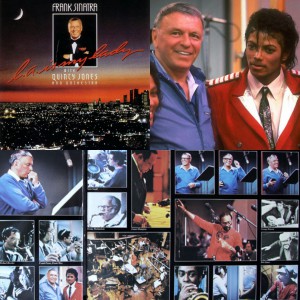 By Jerry Pearce
By Jerry Pearce
In 1958, arranger and conductor Quincy Jones received one of the phone calls of his life when Frank Sinatra invited him to arrange and conduct the orchestra for Sinatra’s concert appearance in Monte Carlo. Although it would be a successful working experience, Jones would not hear from Sinatra again for nearly another six years.
Having worked extensively with Count Basie and his Orchestra in the intervening years, Jones was once again tapped for a job by Sinatra, this time being given the duty of arranging a number of songs for Sinatra’s second album with the Basie band.
Released in 1964, “It Might As Well Be Swing” was another qualified success for Sinatra’s burgeoning Reprise Records label, not only featuring Sinatra and the Count Basie Orchestra performing at full tilt, but also giving birth to two career defining musical arrangements (“Fly Me To The Moon,” “The Best Is Yet To Come”) that Sinatra would perform numerously in concert until the end of his career, both charts penned by Jones.
Two years after this, with producer Sonny Burke running some portable recording equipment in the background, Sinatra began one of his famous concert stands at his home base of the Sands Hotel in Las Vegas, Nevada, during the early months of 1966. With Quincy Jones conducting the Basie Orchestra, Sonny Burke selected songs from numerous captured performances and created the double-record “Sinatra at the Sands,” Sinatra’s first live album. It is today considered one of the finest albums in the Sinatra canon.
Although they would appear together infrequently with the Basie band throughout the remainder of the 1960s, it wouldn’t be until the early 1980s that they began work on another significant collaboration together.
By this time, Quincy had arranged vocal albums for many great contemporary artists of the 1960s and 1970s, not to mention achieving fame as an in-demand orchestral composer for motion pictures. With his recent success as producer of two of Michael Jackson’s most successful albums (“Off The Wall” and the wildly popular “Thriller”), Quincy set out to make another dream a reality: bringing together Frank Sinatra and Lena Horne together for a gala recording project.
With both parties signing onto the project in early 1983, Quincy Jones was determined to create a showbiz spectacular. Somewhat inspired by the deluxe package of Sinatra’s “Trilogy” a few years’ prior, this new album would be a deluxe package featuring three records and more than thirty songs, including an overlong medley and orchestral overture. Remakes of some of each respective artist’s classics would be featured, as well as a series of new songs, the music provided by both an all-star 17-piece jazz band (including Gerry Mulligan, Herbie Hancock, George Benson, Snookie Young, and Lockjaw Davis) along with a larger studio orchestra.
Sessions were scheduled to commence near the end of February of 1983, and with momentum for the occasion building to an all-time high, multiple roadblocks began to appear simultaneously. The death of Don Costa, one of Sinatra’s prime arrangers and for many years functioning also as a musical director at the beginning of the month, was just the start of bad luck. Lena Horne soon developed a troubling nodule on her vocal cords, and while she recovered, the meeting to put finishing touches on the project before recording commenced was pushed farther and farther along. Soon, Sinatra went back on the road with his regular touring schedule, and once time came around to reschedule the meeting, the drive to make the album was lost on both sides. The project was cancelled.
Quincy persevered; he still had a great desire to make an album with the Chairman. Sometime within the year following the cancellation of the Sinatra-Horne package, Jones again presented Sinatra the concept of another recording project, this one extremely scaled down from the grandiose idea of before. Selecting some of the best arrangements created for the cancelled project, along with a few others that had been created in the intervening year, Sinatra agreed to the project, a jazzy song package that would be recorded in New York City in April of 1984.
Taking his cue from the unrealized Sinatra-Horne project, Quincy assembled a top-flight all-star orchestra featuring some of the greatest musicians in both jazz and the general music world itself. Indeed, the musical aggregation formed gave Sinatra the sound of a new orchestral backing unlike any ever heard before behind his voice, including the relatively new advent of a synthesizer.
Orchestral members who played on the album included Sinatra regulars Tony Mottola on guitar and Gene Cherico on bass, joined by but not limited to such greats as Frank Wess, Ray Brown, Lew Soloff, Alan Rubin, Joe Newman, Randy and Michael Brecker, Jim Self, Steve Gadd, and Randy Kerber, complimented by vibraphone master Lionel Hampton as well as the great George Benson. Frank Foster, Sammy Nestico, Torrie Zito and Jones himself contributed musical arrangements, and the entire contingent would meet in New York that April to begin proceedings.
The album would be recorded over the course of three nights in Manhattan, and the studio chosen was that of A&R Recording in Midtown, an independent studio owned by master engineer Phil Ramone, who had worked with Sinatra in New York in the past, the first time being in 1967. Ramone would later work with Sinatra as a producer in the 1990s during Frank’s return Capitol Records, guiding both of Sinatra’s acclaimed (and lambasted) “Duets” albums to fruition.
With Ramone at the panel giving Frank and the band the proper acoustics and balance and Quincy standing before the orchestra with baton, recording soon got underway. The sessions were somewhat of an event, with portions recorded before an invited audience and most of the proceedings filmed by an adjoining camera crew, not to mention two band members bringing along their own personal cameras to capture the event.
Film recorded at that time shows a happy Sinatra in his late sixties, making the most out of the arrangements and the orchestra itself. Even Quincy Jones himself said on the occasion of Sinatra 100th birthday that he had never seen Sinatra so truly happy in a studio setting. One of the more memorable humorous moments was when fellow Quincy Jones collaborator Michael Jackson visited the studio during the proceedings to say hello to Sinatra, Frank most concerned at the moment about getting a Michael Jackson autograph for his young granddaughter.
Twelve complete songs had been recorded during the multiple studio sessions, but one tune, written by pianist Bob James (who plays on the album), was discarded by Sinatra after several run-throughs. “Body and Soul,” a tender loved ballad first recorded by Sinatra in the 1940s while at Columbia Records, was redone in a modern arrangement that some say Sinatra couldn’t properly attach his vocal due to the complexity of the orchestration.
Although the song was left off the finished album, Sinatra’s vocal for the song was used some years later. On the occasion of the release of his United States Postal Stamp in 2008 (marking the tenth anniversary of his death), a new compilation album called “Nothing But The Best” was released. For this release, Frank Sinatra, JR. conducted a new string-based arrangement of the song (by Torrie Zito) from which Sinatra’s vocal was stripped from the 1984 recording and layered onto the new backing. It is a pleasurable listening experience.
As for the rest of the original album, there’s a lot of great things going on. Fred Ebb and John Kander, the two geniuses behind one of Frank’s great hits, the “Theme From New York, New York,” provide him here with the wishful lyrics of “The Best of Everything,” and Sinatra sinks his teeth well into the big band backing. “How Do You Keep The Music Playing,” written by Michel Legrand and Alan and Marilyn Bergman, had already been a successful pop hit (recorded by James Ingram and Patti Austin) and is superbly recast for big band as a Sinatra ballad. Other notable performances include “It’s Alright With Me,” “Teach Me Tonight,” “Stormy Weather,” “If I Should Lose You,” and “A Hundred Years From Today.”
“Mack The Knife” has Bobby Darin’s name written all over it, but Frank provides his own definable stamp on the Kurt Weill showtune on this album as well, with a rousing arrangement written by Frank Foster. Two years after he recorded it, feeling he had improved his work on the song and with the advent of the compact disc soon misplacing the vinyl record in American culture, he would record a new vocal on top of the original arrangement when the album was being prepped for first release as a CD.
The song itself would become a staple in Sinatra concert appearances for the remainder of his career, and was the one arrangement borrowed from this album when Frank moved onto his “Duets” albums, trading lines in that version with guest star Jimmy Buffett.
Unhappy with his initial performance of “Stormy Weather” at the New York sessions of April, Frank would re-record the tune in a higher key that coming May, with the release of the album focused on August.
Originally titled “The Best Of Everything,” a change was soon made when the fledging MTV network became involved with the production. With respect to Sinatra’s success of the “Theme From New York, New York,” those in charge saw the opportunity to create a Sinatra “anthem” of sorts for the West Coast as well by hanging a campaign on another track on the album “L.A. Is My Lady,” resulting in an album title change as well as the production of a music video that would air on the MTV network, helping sustain Sinatra’s image in the face of rapidly changing musical audience.
Featuring many musicians and celebrities of the day, the video would function as both a tribute to the city of Los Angeles as well as that of Sinatra’s career, with even fellow Frank crony Dean Martin making a cameo.
In addition, more than one hour of session footage would be released by MGM/UA as a quasi-documentary entitled “Portrait of an Album,” which also featured interviews with Quincy Jones, Phil Ramone, the Bergman’s, and Lionel Hampton.
Released in August, the album would peak at number fifty-eight on the Billboard 200 music chart, as well as number eight in the list of top jazz albums of 1984. Sinatra would continue to perform the title track, as well as other selections from the album in concert well into the end of the 1980s.
From the opening sounds of the title track to the swingin’ tilt of the finale “After You’ve Gone,” there’s plenty good to be heard here. In the present day, the album is viewed as Sinatra’s true “last stand” in the recording studio. Although a few “singles” sessions and one aborted album attempt would follow, not to mention the production of the “Duets” albums, “L.A. Is My Lady” is truly the last standalone full Sinatra album, with Frank and the band out there holding to the expected norms: kickin’ it old school and swinging their hearts out.
When you view Sinatra’s solo recording career as a whole, it’s a fine close to a forty-five-year long tradition of music making, and as you might expect, is highly recommended.
Until next time, Sinatra lovers!
Jerry Pearce is an amateur singer in the vein of Frank Sinatra, Perry Como, and Dick Haymes and has released two discs of standards music, Crossroads in 2010, and One Summer Night in 2016. Samples of his music can be heard on his YouTube Channel. To purchase his CDs use the form box below.
[si-contact-form form=’3′]

 May 18th, 2016
May 18th, 2016  CEO
CEO  Posted in
Posted in  Tags:
Tags: 



